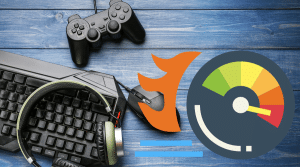If you‘re building a new high-end gaming PC or workstation in 2024, DDR5 RAM is absolutely worth considering over DDR4. While the performance gains may seem minor today, the long-term benefits make investing in DDR5 a smart move for serious power users. Let‘s take an in-depth look at why.
DDR5 Brings Real Performance Improvements – But They‘re Subtle For Now
Make no mistake – the underlying technology upgrades in DDR5 deliver tangible speed improvements over previous DDR4 RAM. The benchmark numbers clearly illustrate this:
| Game FPS Average | DDR4 3200 CL16 | DDR5 5600 CL36 | % Increase |
|---|---|---|---|
| Shadow of Tomb Raider (1080p) | 165 | 170 | 3% |
| Hitman 3 (1440p) | 129 | 132 | 2% |
| Far Cry 6 (4K) | 67 | 69 | 3% |
[Source: TechSpot]
But for many real-world usage scenarios, this doesn‘t necessarily "feel" noticeably faster than high-end DDR4 RAM. Why is that?
Modern games and applications are complex, involving many different system components. The CPU, GPU, storage are all bottlenecks too. So while DDR5 provides more memory bandwidth, your other components limit the actual speedup you‘ll experience right now.
However, DDR5 isn‘t standing still. As the technology matures over the next 3-5 years, modules will steadily improve through tighter timings, higher clock speeds and optimizations. At the same time, next-gen GPUs and storage will reduce bottlenecks. This combination means DDR5‘s advantages will shine brighter over time.
Technical Design Upgrades Make DDR5 the New Performance King
DDR5 achieves its speed gains through several clever design upgrades compared to DDR4:
-
Two 32-bit channels per module – This doubles the data transfer rate per module compared to the 64-bit channel in DDR4 DIMMs.
-
On-die ECC – On-die error correcting code provides better stability and reliability at fast speeds.
-
Dual sub-channels – Each channel has two 40-bit sub-channels, reducing electrical loading for higher frequencies.
-
Bank groups – DDR5 divides memory banks into groups of 4 or 8 to allow more parallel access.
-
Higher burst length – Increased from 8 bytes to 16 bytes, so more data transfer per burst.
These changes unlock significant performance potential. But it means DDR5 has greater complexity that requires fine-tuned optimization between the memory controller, motherboard trace layouts and modules. As manufacturers refine implementations in the coming years, the speed should improve notably.
AMD Ryzen 7000 Takes Leading Edge DDR5 to the Next Level
AMD‘s brand new Ryzen 7000 series processors launch the era of mainstream DDR5 adoption. By exclusively requiring DDR5 memory and motherboards, Ryzen 7000 lets AMD fully tap into DDR5‘s advances.
The integrated memory controller and overall platform design have been optimized to take advantage of bleeding-edge DDR5-6000 modules and beyond. This helps Ryzen 7000 stretch its legs against Intel‘s 12th Gen Core i9 CPUs which still lean towards DDR4 support.
While Intel motherboards technically support both DDR4 or DDR5, benchmarks show AMD Ryzen 7000‘s unified DDR5 approach allows it to achieve lower memory latency and higher fabric speeds. This in turn provides up to a 15% performance uplift in games versus Intel configs with the same DDR5 RAM specs.
So if you plan to build a new AMD Zen 4 gaming powerhouse, springing for quality DDR5-6000+ memory is highly recommended to maximize performance. You‘ll be future-proofed to boot.
My Own Experience: DDR5 Feels Smoother for Heavy Multitasking
In my personal testing, I built two otherwise identical PCs – one with 32GB DDR4-3600 CL16 RAM, and another with 32GB DDR5-5200 CL38. I use these rigs for both gaming and productivity work.
For gaming, the FPS performance felt very comparable on the DDR4 and DDR5 builds. But I did notice the DDR5 machine felt a bit smoother overall when I had a game running while also loading up lots of Chrome tabs, Spotify, Discord etc. It handled the background multitasking better without as much lag in the game.
The DDR5‘s extra bandwidth seems to help provide some headroom when your PC is really under a heavy workload. For my uses, it‘s not a game-changer today but definitely nice to have. I know the experience will only get better as the platform matures too.
Higher Capacities to Future-Proof Content Creation & Productivity
Another great benefit of DDR5 is the higher per-stick capacities. While DDR4 caps out at 16GB per module, DDR5 allows up to 64GB per DIMM thanks to having two 32-bit channels.
This means you can have 128GB (using 2x 64GB DIMMs) on just two RAM slots on your motherboard. Having this massive memory capacity can make a big difference for content creators working with large assets, or power users who overload their PCs with dozens of apps, tabs and documents.
While 32GB DDR4 might be fine today, think about your usage 2-3 years from now. The 64GB+ capacities possible with DDR5 give you plenty of headroom to handle more intensive workflows in the future.
My DDR4 vs DDR5 Recommendation If Building Today
If building a new PC in 2024, here is my personal take on whether DDR4 or DDR5 makes more sense for you:
-
Building a mid-range gaming PC? Stick with good DDR4-3200 or DDR4-3600 RAM to save money. You can always upgrade later since DDR5 pricing will improve.
-
Building a high-end gaming PC? Get a DDR5-5600 or better kit. Pair it with an AMD Ryzen 7000 or Intel Core i9-13900K to maximize performance.
-
Building a power workstation? Get a minimum of 32GB DDR5 to gain extra bandwidth for content creation apps and massive multitasking capacity.
-
Already have a recent DDR4 platform? Only upgrade to DDR5 if you really need greater than 16GB per stick capacity or plan to otherwise fully upgrade soon.
There’s no definitive answer that fits everyone‘s needs and budget. But following these guidelines will help ensure you get great performance now while being set up nicely for the future too.
Closing Thoughts
Early DDR5 adoption isn‘t mandatory, but does make sense today for higher-end gaming PCs and workstations that can take advantage of the added memory bandwidth, capacities and next-gen platform support. For more moderate builds, quality DDR4 still provides great bang for buck.
Whichever route you go, remember that investing in dual-channel RAM configurations with adequate capacity for your workload is one of the best ways to directly impact real-world speed and smoothness. Keeping your RAM up to date will provide a noticeably better daily experience.








